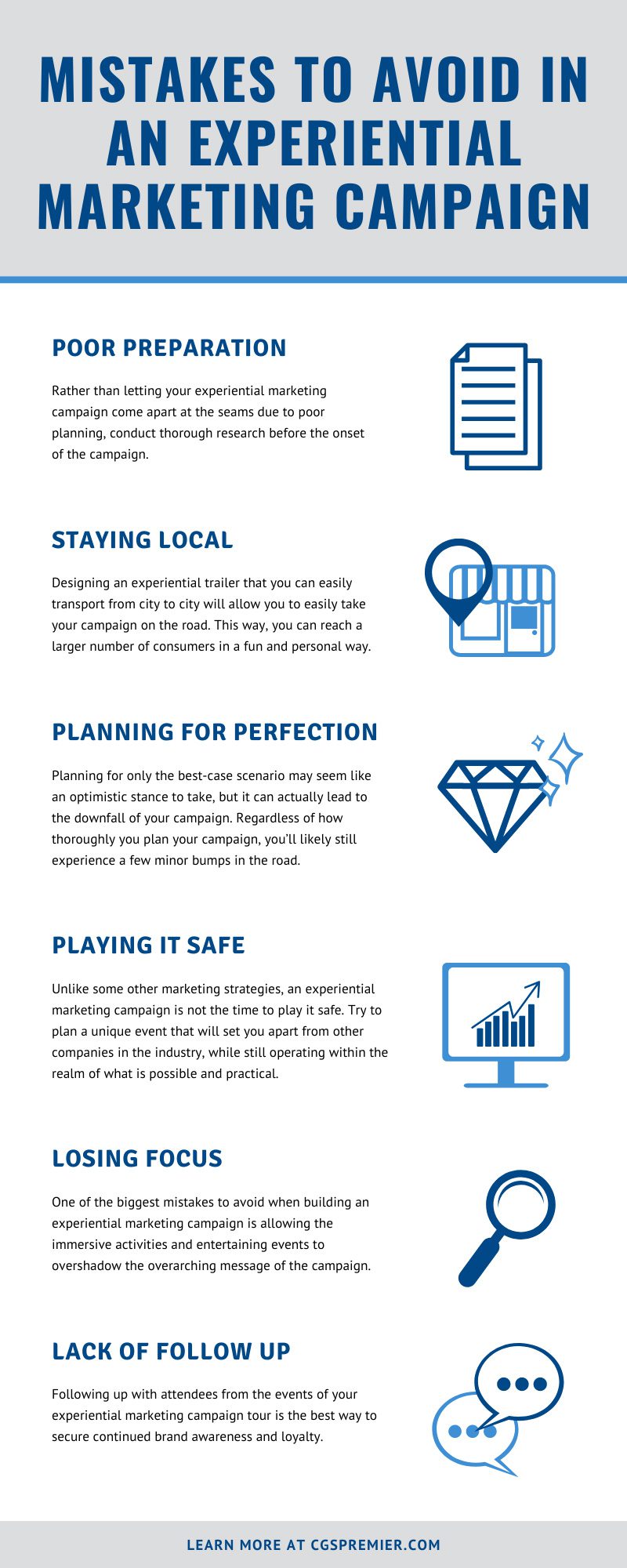Building a marketing strategy is a complex process that involves a considerable amount of thought and preparation. A successful marketing strategy can lead to a significant increase in product sales; however, a poorly executed marketing strategy can spell trouble for even the most successful businesses. While every marketing strategy will be a little different, there are a few key points that every strategy should be sure to hit and some mistakes they should avoid. This guide to some of the most common mistakes to avoid when building an experiential marketing campaign will help you sidestep some of these marketing pitfalls. This way, you can achieve a more successful marketing campaign.
Poor preparation
Before jumping headfirst into an experiential marketing campaign, one should always take the time to plan out all aspects of the campaign—down to even the most minute details. Poor preparation and planning can cause your campaign to appear unprofessional and it may even seem as though it’s been haphazardly thrown together. Rather than letting your experiential marketing campaign come apart at the seams due to poor planning, conduct thorough research before the onset of the campaign. When planning and researching, be sure to conduct thorough market research regarding the wants and needs of your company’s target demographic. Gaining a thorough understanding of the age, gender, and cultural background of your intended audience will give you a better insight into their behaviors as consumers. It will help you better tailor your experiential marketing campaign according to their wants and needs. This market research will also aid in other aspects of building your experiential marketing campaign, including the campaign’s overarching marketing strategy and the components used to engage the audience.
Staying local
One of the largest advantages of experiential marketing campaigns is their innate ability to attract consumers from far and wide. However, remaining local and establishing your experiential marketing event in one permanent location will severely limit the range of audience visiting your event. Taking your experiential marketing campaign on the road is a far better option, as it allows you to reach members of your target demographic on their own home turf. Designing an experiential trailer that you can easily transport from city to city will allow you to easily take your campaign on the road. This way, you can reach a larger number of consumers in a fun and personal way. When selecting the stops on your mobile marketing tour, try to choose locations that correlate with key aspects of your target demographic. For instance, say your target demographic is young adults with an affinity for live entertainment and exceptional experiences. You may consider choosing campaign stops that correlate with the locations of popular music festivals.
Planning for perfection
Preparation is crucial to the success of your experiential marketing campaign, and there’s often no such thing as being too prepared. As you begin preparations for you’re experiential marketing campaign, it’s important to consider all possible scenarios, including those which may be a bit unsavory. Planning for only the best-case scenario may seem like an optimistic stance to take, but it can actually lead to the downfall of your campaign. Regardless of how thoroughly you plan your campaign, you’ll likely still experience a few minor bumps in the road. When planning your experiential marketing campaign, it’s best to prepare for all possible outcomes, including the worst-case scenario. Planning for potential problems will better equip you to handle these hiccups when they inevitably occur, which will, in turn, help your campaign operate more smoothly overall.
Playing it safe
Experiential marketing campaigns are so popular and successful because they allow the company to step outside their comfort zone and market their products in a fun and creative way. Unlike some other marketing strategies, an experiential marketing campaign is not the time to play it safe. Planning an experiential marketing campaign that follows the outline of campaigns by other companies will cause your audience to become bored. As such, you’ll likely see a less than impressive turnout at events. Coloring a bit outside the lines, however, can lead to interesting and innovative discoveries that will draw crowds from far and wide. Try to plan a unique event that will set you apart from other companies in the industry, while still operating within the realm of what is possible and practical.
Losing focus
One of the biggest mistakes to avoid when building an experiential marketing campaign is allowing the immersive activities and entertaining events to overshadow the overarching message of the campaign. Outfitting your experiential marketing event with fun games, eye-catching photo ops, and an abundance of inflatable animals (which seem to be all the rage right now) is a great way to attract consumers to your event. However, overcrowding the space with these attractions can quickly cause attendees to lose sight of the campaign’s main message. Each interactive element of the experiential marketing event should connect back to the overarching mission of the campaign in some way. If you add these elements without considering how they connect to the bigger picture, they can easily appear as pandering or gimmicky. Choose interactive elements that will allow event attendees to have a bit of fun while also thinking critically about the products or services on display.
Lack of follow up
Even after your experiential marketing campaign’s final event has ended, the work is far from over. Many individuals may see this conclusion as the perfect opportunity to kick their feet up and indulge in some much-needed relaxation. However, it’s important to still keep your nose to the grindstone and tie up all the loose ends of the campaign. Following up with attendees from the events of your experiential marketing campaign tour is the best way to secure continued brand awareness and loyalty. Further, contacting attendees via email and encouraging them to complete a survey regarding their experiences and perceptions of the event will help you understand what worked and what didn’t. This information will propel you to make specific changes that will benefit all future experiential marketing events for your company. Providing attendees with a small incentive for completing the survey, such as a discount on products or services, will yield a larger number of completed surveys. This, in turn, will help produce more beneficial information.





